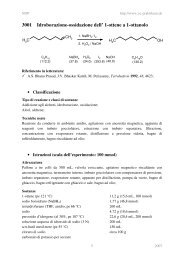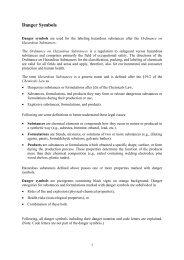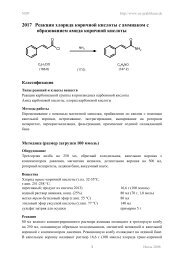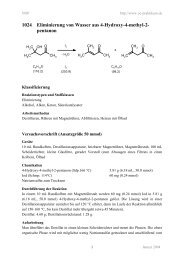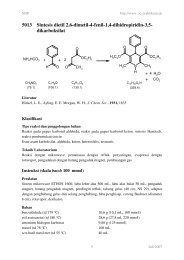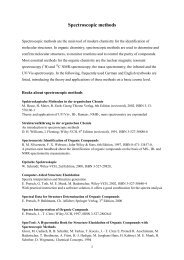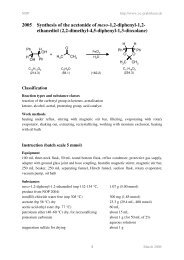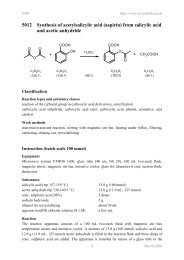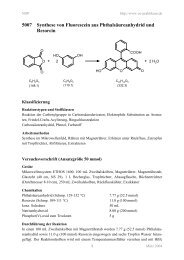Synthesis instructions as PDF file for printing - kriemhild
Synthesis instructions as PDF file for printing - kriemhild
Synthesis instructions as PDF file for printing - kriemhild
Create successful ePaper yourself
Turn your PDF publications into a flip-book with our unique Google optimized e-Paper software.
NOP http://www.oc-praktikum.de<br />
2004 Di<strong>as</strong>tereoselective reduction of benzoin with sodium<br />
borohydride to 1,2-diphenyl-1,2-ethanediol<br />
Ph<br />
OH<br />
O<br />
Ph<br />
NaBH 4<br />
C 14 H 12 O 2<br />
(212.3) (37.8)<br />
Ph<br />
1<br />
H<br />
OH<br />
HO H<br />
Ph<br />
+<br />
C 14 H 14 O 2<br />
(214.3)<br />
Ph<br />
H<br />
OH<br />
Ph<br />
H OH<br />
meso racemic<br />
Literature<br />
M. Yamada, T. Horie, M. Kawai, H. Yamamura, S. Araki, Tetrahedron 1997, 53, 15685<br />
Cl<strong>as</strong>sification<br />
Reaction types and substance cl<strong>as</strong>ses<br />
reaction of the carbonyl group in ketones, reduction, stereoselective addition<br />
ketone, alcohol, complex metal hydride<br />
Work methods<br />
stirring with magnetic stir bar, adding dropwise with an addition funnel, evaporating with<br />
rotary evaporator, filtering, recrystallizing, heating with oil bath<br />
Instruction (batch scale 10 mmol)<br />
Equipment<br />
500 mL three-neck fl<strong>as</strong>k, reflux condenser, addition funnel with pressure balance, internal<br />
thermometer, bubble counter, 500 mL Erlenmeyer fl<strong>as</strong>k, separating funnel, 500 mL round<br />
bottom fl<strong>as</strong>k, heatable magnetic stirrer, magnetic stir bar, rotary evaporator, suction fl<strong>as</strong>k,<br />
Buechner funnel, desiccator, oil bath<br />
Substances<br />
benzoin (mp 132-134 °C) 2.13 g (10.0 mmol)<br />
sodium borohydride 0.756 g (20.0 mmol)<br />
tert-butyl methyl ether (bp 55 °C) 300 mL<br />
conc. hydrochloric acid (25%) 4 mL<br />
ice 30 g<br />
sodium sulfate <strong>for</strong> drying<br />
ethanol (bp 78 °C) <strong>for</strong> recrystallizing about 3 mL<br />
March 2006
NOP http://www.oc-praktikum.de<br />
Reaction<br />
0.756 g (20.0 mmol) sodium borohydride in 40 mL tert-butyl methyl ether are filled in a dry<br />
500 mL three-neck fl<strong>as</strong>k with magnetic stir bar, internal thermometer, addition funnel and<br />
reflux condenser with bubble counter (filled i.e. with paraffin oil) and stirred <strong>for</strong> about 10<br />
minutes until a fine suspension h<strong>as</strong> <strong>for</strong>med. 2.13 g (10.0 mmol) benzoin are dissolved in an<br />
Erlenmeyer fl<strong>as</strong>k in 260 mL tert-butyl methyl ether under slight heating to about 30°C. The<br />
solution is cooled down to room temperature and added dropwise over an addition funnel into<br />
the reaction fl<strong>as</strong>k at such a rate, that the temperature of the reaction solution does not exceed<br />
30°C (about 20 minutes). Afterwards the mixture is stirred <strong>for</strong> at le<strong>as</strong>t further 4 hours (or over<br />
night) at room temperature.<br />
Work up<br />
30 g finely crunched ice is added to the reaction mixture. Then a mixture of 4mL conc.<br />
hydrochloric acid (25%) and 20 mL water (equivalent to about 1 M HCl) is slowly added<br />
dropwise over an addition funnel (within about 30 min). During the addition strong evolution<br />
of g<strong>as</strong> can be observed. Stirring is continued until no more g<strong>as</strong> is <strong>for</strong>med (about 10 min).<br />
Even if diluted hydrochloric acid is added dropwise, no g<strong>as</strong> evolution should be visible.<br />
The organic ph<strong>as</strong>e is separated in a separating funnel and dried with sodium sulfate. After the<br />
drying agent h<strong>as</strong> been filtered off, the solvent is evaporated at the rotary evaporator. The<br />
crude product remains <strong>as</strong> crystalline solid.<br />
Crude yield: 2.14 g; mp 125-129 °C; (see analytics)<br />
The crude product is recrystallized from an ethanol water mixture (1:1) (about 6 mL).<br />
Yield: 1.86 g (8.69 mmol, 87%), mp 132-134 °C; colourless crystals; HPLC-purity > 99%<br />
Comments<br />
The stereochemistry of the product is investigated in experiment 2005.<br />
W<strong>as</strong>te management<br />
Recycling<br />
The evaporated tert-butyl methyl ether is collected and redistilled.<br />
W<strong>as</strong>te disposal<br />
W<strong>as</strong>te Disposal<br />
aqueous ph<strong>as</strong>e from separating funnel solvent water mixtures, containing halogen<br />
mother liquour from recrystallization solvent water mixtures, halogen free<br />
sodium sulfate solid w<strong>as</strong>te, free from mercury<br />
Time<br />
About 7 hours<br />
Break<br />
During work up after separating of the ph<strong>as</strong>es<br />
Degree of difficulty<br />
Medium<br />
2<br />
March 2006
NOP http://www.oc-praktikum.de<br />
Analytics<br />
Reaction monitoring<br />
The reaction can be monitored with TLC and HPLC.<br />
Sample preparation:<br />
Using a P<strong>as</strong>teur pipette, 5 mL from the reaction solution are taken <strong>for</strong> each sample and filled in a small<br />
Erlenmeyer fl<strong>as</strong>k containing 1g crunched ice. 5 mL 0.1 M HCl are added slowly and the mixture is shaken until<br />
no more g<strong>as</strong> is <strong>for</strong>med. The pH-value of the aqueous ph<strong>as</strong>e should be in the slightly acidic range, otherwise some<br />
drops of hydrochloric acid are added. The ph<strong>as</strong>es are separated in a small separating funnel. Samples <strong>for</strong> TLC<br />
can be taken directly from the organic ph<strong>as</strong>e. For HPLC the organic ph<strong>as</strong>e is dried with sodium sulfate, filtered<br />
and the solvent is evaporated. 0.5 mg of the residue are dissolved in 2 mL acetonitrile.<br />
TLC<br />
TLC-conditions:<br />
adsorbant: TLC-alufoil silica gel 60 F254<br />
eluent: petroleum ether/acetic acid ethyl ester 7:3<br />
Rf (benzoin) 0.4<br />
Rf (product) 0.2<br />
HPLC<br />
HPLC-conditions:<br />
column: Phenomenex Luna C18; particle size 3 µm, length 150 mm, internal diameter 4.6 mm<br />
column temperature: 25 °C<br />
injection volume: 10 µL<br />
gradient: 0 min 5% acetonitrile + 95% water<br />
40 min 95% acetonitrile + 5% water<br />
50 min 95% acetonitrile + 5% water<br />
flow: 1.0 mL/min<br />
wave length: 220 nm<br />
Percent concentration w<strong>as</strong> calculated from peak are<strong>as</strong>.<br />
3<br />
March 2006
NOP http://www.oc-praktikum.de<br />
HPLC of the crude product<br />
mAU<br />
1200<br />
1000<br />
800<br />
600<br />
400<br />
200<br />
0<br />
mAU<br />
1200<br />
1000<br />
800<br />
600<br />
400<br />
200<br />
0<br />
16.889<br />
0 5 10 15 20 25 30 35 40 45<br />
16.912<br />
Retention time (min) Substances<br />
4<br />
Peak area %<br />
after 1h after 4 h<br />
16.9 meso-product 64.6 97.3<br />
18.0 racemic product 2.7 2.7<br />
20.8 benzoin 31.9 –<br />
others not identified 0.7 –<br />
A quantitative analysis of the diol in the crude product with HPLC and internal standard resulted in a purity<br />
of > 99% (mixture of di<strong>as</strong>tereomers).<br />
With HPLC no racemic compound can be identified in the recrystallized product.<br />
17.957<br />
17 .9 86<br />
20.823<br />
Work up 1 hour<br />
after the addition of benzoin is finished<br />
Work up 4 hours<br />
after the addition of benzoin is finished<br />
0 5 10 15 20 25 30 35 40 45<br />
min<br />
min<br />
March 2006
NOP http://www.oc-praktikum.de<br />
1 H NMR spectrum of the crude product (250 MHz, CDCl3)<br />
9. 0<br />
8. 0<br />
7. 0<br />
6. 0<br />
5. 0 4. 0<br />
(ppm)<br />
1 H NMR spectrum of the pure product (250 MHz, CDCl3)<br />
8. 0<br />
7. 0<br />
6. 0<br />
5. 0<br />
4. 0<br />
(ppm)<br />
δ (ppm) Multiplicity Number of<br />
H<br />
Assignment<br />
2.14 Wide s 2 CH – OH<br />
4.81 S 2 CH – OH (meso-Isomer)<br />
7.21 - 7.31 M 10 CH arene<br />
The weak signal at δ = 4.72 ppm in the spectrum of the crude product corresponds to proton R1R2CH – OH in<br />
the racemat, resulting in a relation of the meso-product to the racemic product of 98:2.<br />
5<br />
3. 0<br />
3. 0<br />
2. 0<br />
2. 0<br />
1. 0<br />
1. 0<br />
0. 0<br />
0. 0<br />
March 2006
NOP http://www.oc-praktikum.de<br />
1 H NMR spectrum of the crude product (250 MHz, DMSO-D6)<br />
9<br />
In contr<strong>as</strong>t to the spectrum in CDCl3, the spectrum of the crude product in DMSO shows still some <strong>for</strong>eign<br />
signals, <strong>for</strong> the racemic isomer no separate signal can be detected.<br />
1 H NMR spectrum of the pure product (250 MHz, DMSO-D6)<br />
9<br />
8<br />
8<br />
7<br />
7<br />
5.3<br />
5.4<br />
6<br />
6<br />
5.2<br />
δ (ppm) Multiplicity Number of<br />
H<br />
Assignment<br />
2.49 m DMSO<br />
3.33 s H2O<br />
4.53 – 4.59 m 2 CH – OH<br />
5.17 – 5.23 m 2 CH – OH<br />
7.22 m 10 CH arene<br />
5<br />
5.1<br />
5<br />
5.2<br />
(ppm)<br />
(ppm)<br />
5.0<br />
4<br />
4<br />
5.0<br />
4.9<br />
(ppm)<br />
(ppm)<br />
6<br />
3<br />
4.8<br />
3<br />
4.8<br />
4.7<br />
2<br />
2<br />
4.6<br />
4.6<br />
1<br />
4.5<br />
1<br />
4.4<br />
0<br />
0<br />
March 2006
NOP http://www.oc-praktikum.de<br />
1 H NMR spectrum of the pure product (250 MHz, DMSO-D6) with D2O-exchange<br />
9<br />
δ (ppm) Multiplicity Number of<br />
H<br />
Assignment<br />
2.49 m DMSO<br />
3.58 s H2O<br />
4.56 m 2 CH – OH<br />
7.22 m 10 CH arene<br />
13 C NMR spectrum of the pure product (250 MHz, CDCl3)<br />
200<br />
8<br />
180<br />
160<br />
140<br />
δ (ppm) Assignment<br />
78.1 CH – OH<br />
127.1 CH arene<br />
128.1 CH arene<br />
128.2 CH arene<br />
139.8 Cquart arene<br />
76.5 - 77.5 solvent<br />
7<br />
6<br />
120<br />
5<br />
(ppm)<br />
100<br />
(ppm)<br />
4<br />
80<br />
7<br />
3<br />
60<br />
2<br />
40<br />
1<br />
20<br />
0<br />
0<br />
March 2006
NOP http://www.oc-praktikum.de<br />
IR spectrum of the crude product (KBr)<br />
Transmission [%]<br />
70<br />
60<br />
50<br />
40<br />
30<br />
20<br />
10<br />
0<br />
4000 3500 3000 2500 2000 1500 1000 500<br />
W ellenzahl [cm -1 ]<br />
IR spectrum of the pure product (KBr)<br />
Transmission [%]<br />
80<br />
70<br />
60<br />
50<br />
40<br />
30<br />
20<br />
10<br />
0<br />
4000 3500 3000 2500 2000 1500 1000 500<br />
Wellenzahl [cm -1 ]<br />
(cm -1 ) Assignment<br />
3380 O – H – valence<br />
3300 O – H – valence<br />
3080 C – H – valence, arene<br />
3050 C – H – valence, arene<br />
2896 C – H – valence, alkane<br />
1500 C = C – valence, arene<br />
8<br />
March 2006



